-
CATEGORY ::
- All Seeds /
- All Flower Seeds





Passion Flower Seeds
SEASON
Perennial
USDA ZONES
8 - 10
HEIGHT
96 - 180 inches (vining)
BLOOM SEASON
Summer and fall
BLOOM COLOR
White with blue
ENVIRONMENT
Full sun
SOIL TYPE
Moist, well-drained, pH 6.1 - 7.5
DEER RESISTANT
Yes
HOUSE PLANT
Yes
SEASON
Perennial
USDA ZONES
5 - 10
HEIGHT
10 inches
BLOOM SEASON
Spring through winter
BLOOM COLOR
Mix
ENVIRONMENT
Partial shade
SOIL TYPE
Well-drained, pH 6.1 - 7.5
DEER RESISTANT
Yes
HOUSE PLANT
Yes
LATIN NAME
Sinningia speciosa
SEASON
Annual
USDA ZONES
5 - 10
HEIGHT
8 inches
WIDTH
30 inches
BLOOM SEASON
Mid spring to early fall
BLOOM COLOR
Yellow with white edge
GROWTH RATE
Fast
ENVIRONMENT
Full sun
DEER RESISTANT
Yes
LATIN NAME
Limnanthes douglasii
SEASON
Annual
USDA ZONES
3 - 11
HEIGHT
120 inches
BLOOM SEASON
Spring to fall
BLOOM COLOR
Purple
ENVIRONMENT
Full sun to partial shade
SOIL TYPE
Rich, loamy soil, pH 5.5 - 6.5
DEER RESISTANT
No
SEASON
Perennial
USDA ZONES
7 - 11
HEIGHT
28 inches
BLOOM SEASON
Spring to fall
BLOOM COLOR
Rosy purple
ENVIRONMENT
Full sun to partial shade
SOIL TYPE
Well drained soils, pH 6.6 to 7.5
DEER RESISTANT
Yes
SEASON
Perennial
USDA ZONES
7 - 11
HEIGHT
4 inches
WIDTH
12 - 18 inches
BLOOM SEASON
Early spring to early fall
BLOOM COLOR
Pink
ENVIRONMENT
Full sun to partial shade
FOOT TRAFFIC
Light
DEER RESISTANT
Yes
SEASON
Annual
USDA ZONES
3 - 11
HEIGHT
100 - 140 inches
BLOOM SEASON
Late spring to late summer
BLOOM COLOR
Mix
ENVIRONMENT
Full sun
SOIL TYPE
Well drained, pH 6.6 - 7.5
DEER RESISTANT
No
HOUSE PLANT
No
SEASON
Annual
USDA ZONES
4 - 9
HEIGHT
12 inches
BLOOM SEASON
Late summer to early fall
BLOOM COLOR
Mix
ENVIRONMENT
Full sun
SOIL TYPE
Moist, well-drained, pH 6.6 - 7.3
DEER RESISTANT
Yes
About...
Passion Flower (Passiflora Caerulea) - What an exotic, lovely plant for your garden! Grown from Passion Flower seeds, this vining perennial can grow to 180 inches or more, and it produces large, 4 inch pale blue blossoms. Passion Flower fruit are egg-shaped, orange and edible but not very noteworthy. Passion Flower Vine is native to Southern Brazil and Argentina, and is popular all the way to the southern United States.
MORE FLOWER OPTIONS
Planting Directions
TEMPERATURE
75F
AVERAGE GERM TIME
28 - 90 days
LIGHT REQUIRED
No
DEPTH
1/4 inch
SOWING RATE
1 seed per plant
MOISTURE
Keep seed moist until germination
PLANT SPACING
18 inches
Passion Flower (Passiflora Caerulea) - What an exotic, lovely plant for your garden! Grown from Passion Flower seeds, this vining perennial can grow to 180 inches or more, and it produces large, 4 inch pale blue blossoms. Passion Flower fruit are egg-shaped, orange and edible but not very noteworthy.
Cold hardy
Passion Flower Vine is native to Southern Brazil and Argentina, and is popular all the way to the southern United States. This variety can be grown further north with moderate success and is hardy down to 10 degrees F.

Flower seed | passion flower
How to grow
How To Grow Passion Flower From Seed: Gardeners grow Passion Flower from seed, but the flower seed can be slow to germinate. It actually has a chemical in the seed to keep germination slow. It is recommended to soak the flower seed 24 hours before planting, and sow the Passion Flower seeds 1/4 inch deep in good compost or potting soil. In place of soaking in water, you can soak them in pulpy passion fruit juice. The acid helps break down the seed shell and helps in germination. Keep soil damp, but not too wet.
It is best to start Passion Flower seeds in containers. Once Passion Flower seedlings have 4 - 5 leaves, they can be hardened off and transplanted into the garden. Passion Flower plants need to be well watered through out the summer months, watering infrequently but deeply to encourage deep root growth. During the winter months keep the soil on the dry side so it will go semi-dormant. Must be planted in well-draining soil mix, equal parts gravel and soil.
- Sowing Rate: 1 seed per plant
- Average Germ Time: 28 - 90 days
- Keep moist until germination
- Attracts bees, butterflies and hummingbirds
- Depth: 1/4 inch

Flower Specifications
Passion Flower can die back due to a severe freeze but has been known to grow back from its deep roots. Many gardeners will bring their blue Passion Flower Vine indoors each winter. Passion Flower is an evergreen in tropical or semi-tropical regions, but as the winters become cooler it will drop its leaves. You do need to prune new growth occasionally to promote flowering.
- Height: 96 - 180 inches (vining)
- USDA Zones: 8 - 10
- Season: Perennial
- Deer Resistant: Yes
Common Questions
How can I use passion flower in my garden?
These vigorous climbers are great for arbors, pergolas, trellises, patio containers, wall side borders, walls and fences.
What are the watering recommendations for passion flower?
Water your passion flowers thoroughly but infrequently. By encouraging them to reach deep into the soil for moisture, you help them develop a strong root system that can withstand droughts and frost. During the winter months, make sure to keep the soil relatively dry.
Do I need to fertilize my passion flower plants?
Use fertilizer sparingly, and avoid excessive manure or compost, as this can lead to abundant leafy growth at the expense of flowering.
Should I prune my passion flowers?
This vine can rapidly reach heights of up to 5 feet in a container and can grow 15 to 20 feet when planted in the ground. Avoid attempting to train your passion flower to remain overly neat and compact. Instead, let the branches hang loosely and droop slightly, as these are the ones most likely to produce blooms.
Will these blooms attract butterflies?
Yes, butterflies are very fond of the passion flower.
Planting Directions
TEMPERATURE
70 - 75F
AVERAGE GERM TIME
21 - 28 days
LIGHT REQUIRED
Yes
DEPTH
Do not cover the seed but press into the soil
SOWING RATE
4 seeds per plant
MOISTURE
Keep seed moist until germination
PLANT SPACING
10 inches
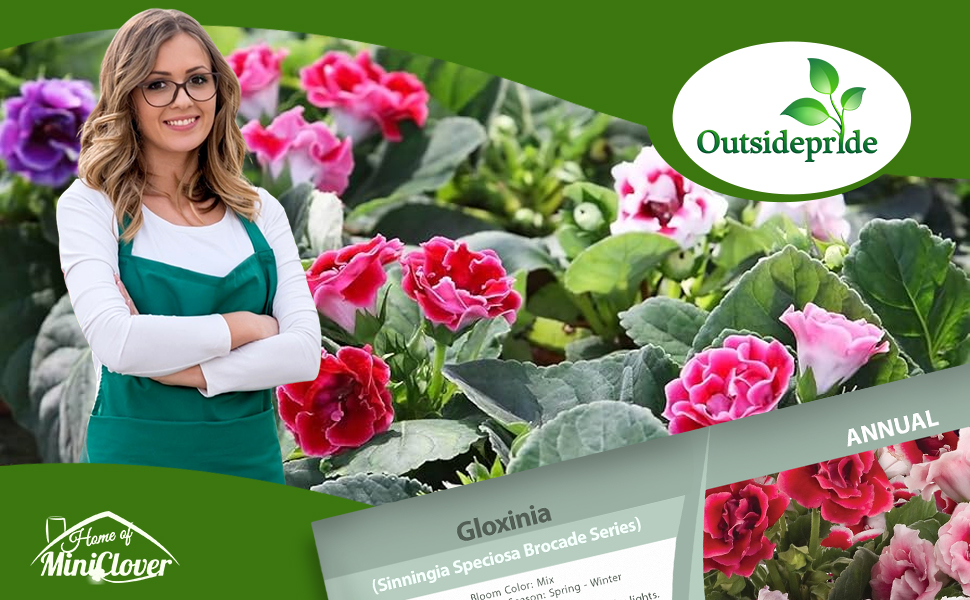
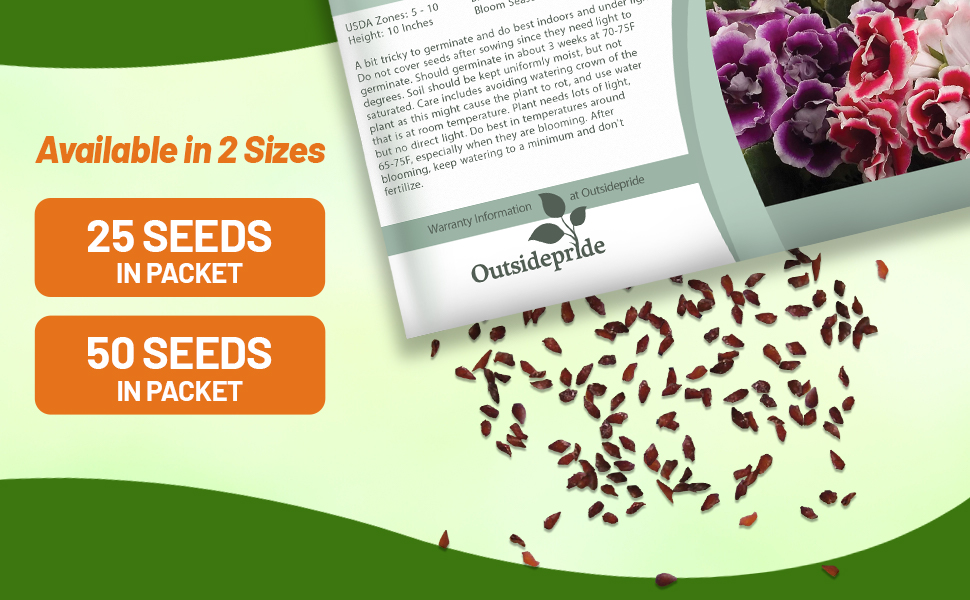
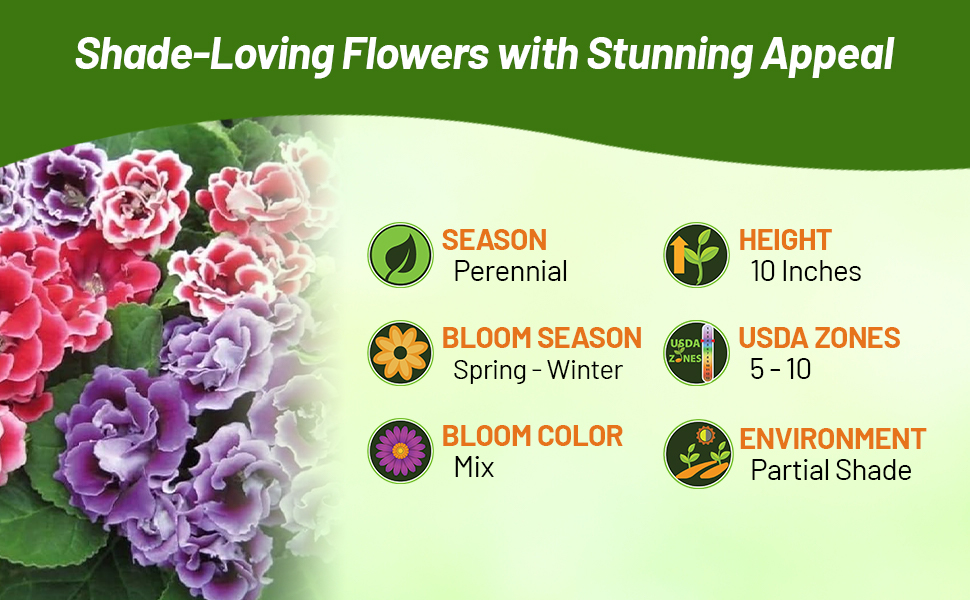
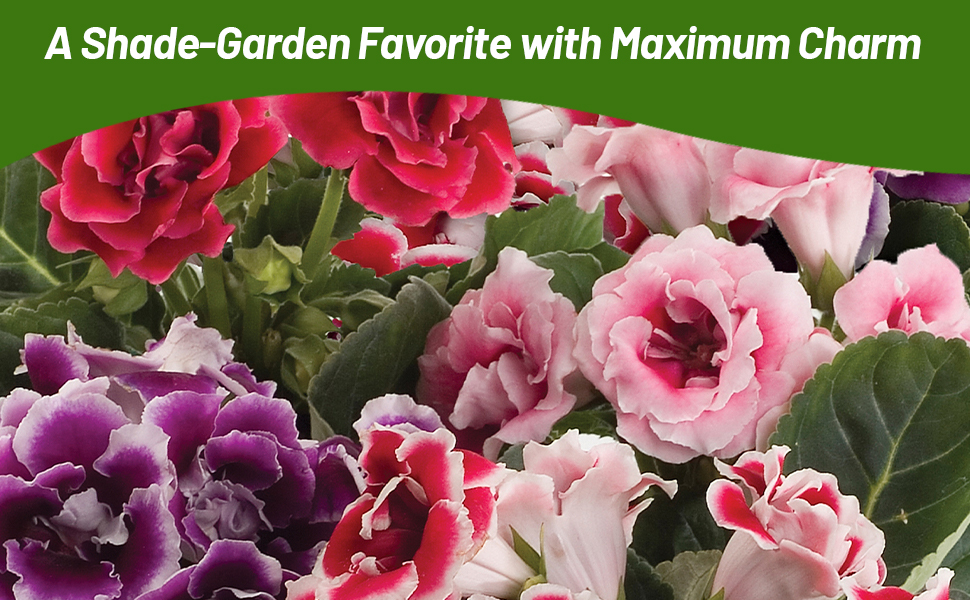
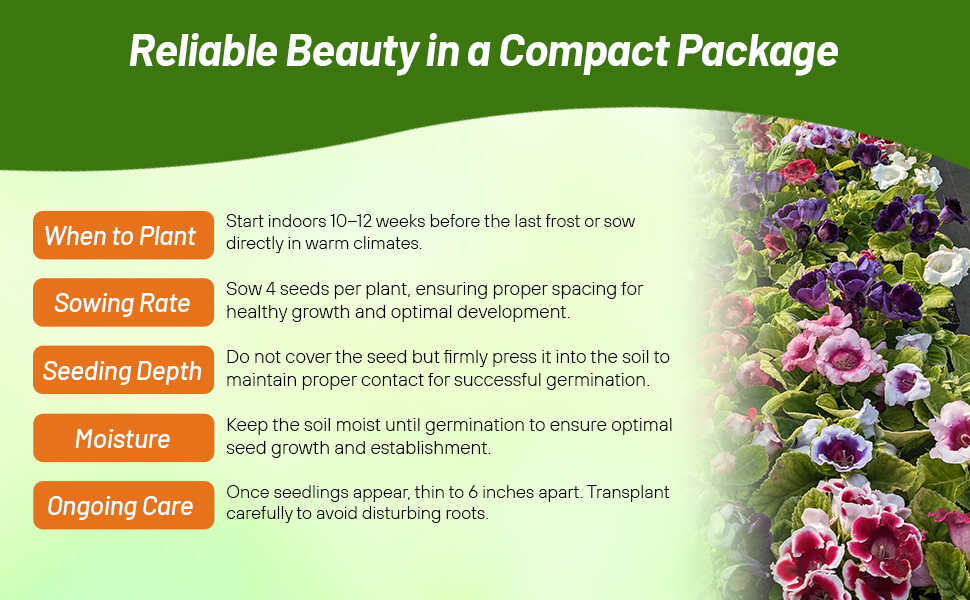
Gloxinia (Sinningia Speciosa Brocade Series) - Sow Gloxinia seeds to produce a beautiful mixture of red, blue, and white blooms. These compact Gloxinia plants blossom four to six months after sowing. They will flower for about 2 months, go dormant for about 2 months, and then begin growing again and start flowering. Gloxinias make a great house plant, giving wonderful, colorful blooms! Sinningia Speciosa is often referred to as Florist's Gloxinia or Brazilian Gloxinia.
Gloxina seeds are a bit tricky to germinate and do best indoors and under lights. Do not cover the flower seeds after sowing since they need light to germinate. Sinningia Speciosa seeds should germinate in about 3 weeks at 70 - 75F degrees. Soil should be kept uniformly moist, but do not keep it saturated. Florist's Gloxinia care includes avoiding watering the crown of the plant as this might cause the plant to rot, and use water that is at room temperature for watering. The Brazilian Gloxinia plant needs lots of light, but no direct light. Gloxinias do best in temperatures around 65 - 75F degrees, especially when they are blooming. After blooming, keep watering to a minimum and don't fertilize.
Common Questions
Do I need to prune my gloxinia?
To encourage a longer bloom season, you will need to deadhead your spent flowers. After the bloom period is over and your plant enters dormancy, prune back any dead or dying foliage.
My leaves are dropping, what do I do?
This can occur from sudden temperature changes such as drafts.
My leaves look scorched, why?
Direct sunlight can burn the leaves of your gloxinia, causing them to scorch and crisp.
My flowers are losing their vibrancy, what do I do?
This is typically caused by inadequate light move your plant to an area with more light but not direct sunlight.
Planting Directions
TEMPERATURE
70F
AVERAGE GERM TIME
14 - 21 days
LIGHT REQUIRED
Yes
DEPTH
Sow seed 1/8 inch deep
SOIL TYPE
Fertile, well draind soil from sandy loam to clay
SOWING RATE
Approximately 1000 seeds covers 20 square feet or 3 - 4 seeds per plant
MOISTURE
Keep seeds moist until germination occurs
PLANT SPACING
24 inches


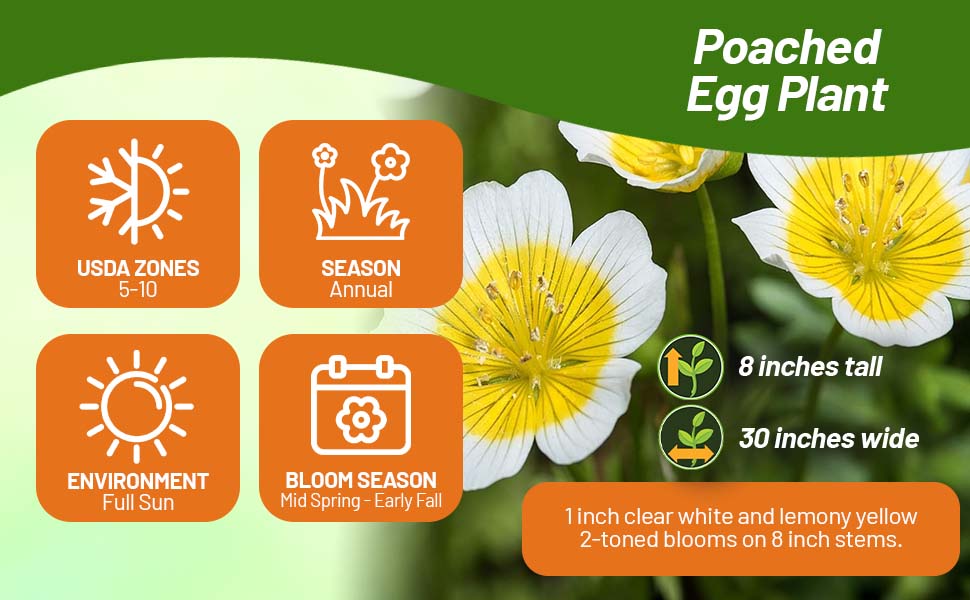
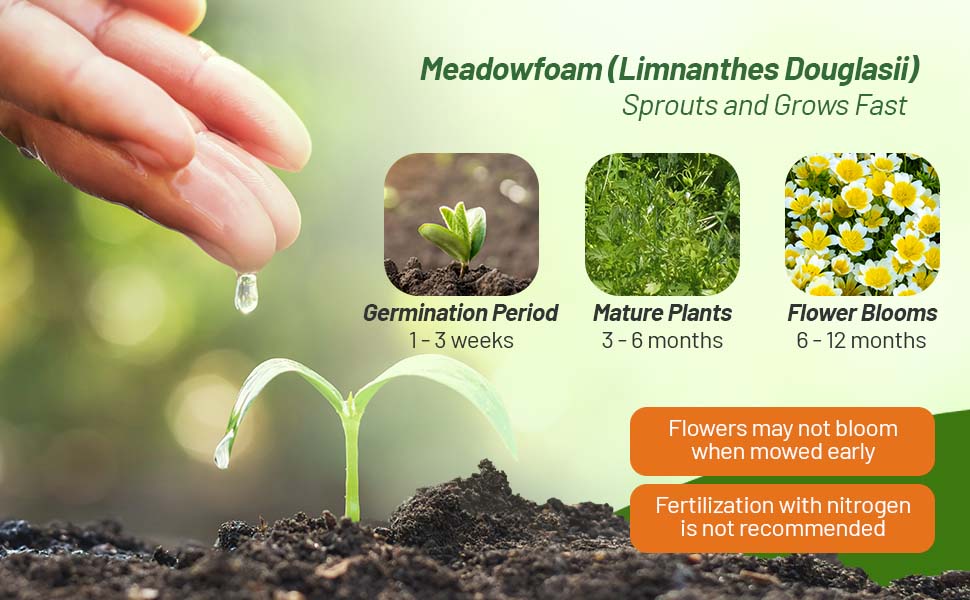
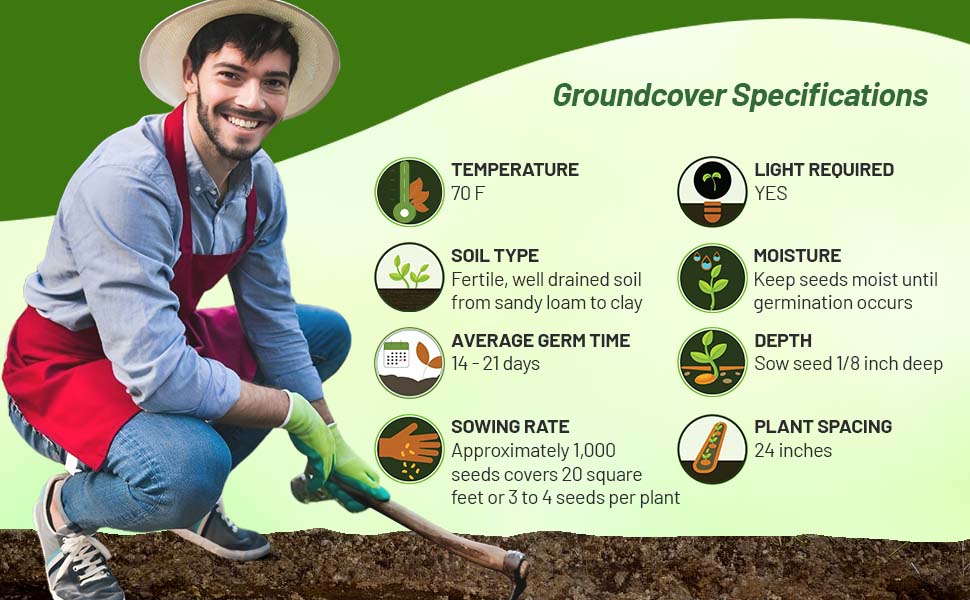
Meadowfoam (Limnanthes Douglasii) - Grow Limnanthes Douglasii seeds for this annual that is native to California. Limnanthes is commonly called Poached Egg Plant or Meadowfoam, and it is not only visually very striking and attractive, but it also has a very nice aroma as well. Limnanthes Poached Egg Plant is not fussy about soil, and it will easily and quickly spread, creating a low-growing, shiny, carpet. Each meadowfoam plant can spread up to 30 inches! Poached Egg Limnanthes is a very long blooming annual with a mass of charming, 1 inch clear white and lemony yellow 2-toned blooms on 8 inch stems. It easily sows its own flower seeds for next year's display. Meadowfoam plants are great as a ground cover plant, and they will grow well in pots too.
Sow Limnanthes Douglasii seeds directly outdoors in a prepared seedbed in spring after danger of frost has passed. Meadowfoam seed should be pressed into the soil and very lightly covered with soil. When large enough to handle, thin the Poached Egg Plant seedlings.
Common Questions
What are these flowers used for in the landscape?
These are great for beds and borders, city gardens, prairie gardens, cottage gardens and in containers.
Do these flowers attract any pollinators?
Yes, these flowers will reward your garden by attracting bees, butterflies and pollinating insects.
Do I need to prune at the end of their bloom season?
Yes, these should be pruned back after they are done flowering.
Planting Directions
TEMPERATURE
60 - 65F
AVERAGE GERM TIME
12 - 40 days
LIGHT REQUIRED
Yes
DEPTH
1/16th inch deep
SOWING RATE
2 - 3 seeds per plant
MOISTURE
Keeps seeds moist until germination
PLANT SPACING
10 - 12 inches
Purple Bell Vine (Rhodociton Atrosanguineus) - Grow Rhodociton Atrosanguineus seeds for an exotic vine that will have everyone's attention! Rhodociton Purple Bell Vine has heart-shaped leaves and dark purple bell-shaped flowers that dangle from thread-like stems. Bell Vine uses include baskets where it will cascade over the edges and look stunning or give it a trellis where it will grow with support up to 120 inches in height. Rhodociton Purple Bells needs rich, well-drained soil and full sun to partial shade although it prefers afternoon shade in hotter climates. Purple Bells bloom from late spring to late fall.
Sow Purple Bell Vine seeds indoors in late winter. Gently press the flower seeds into the soil and barely cover the seed with soil. Keep consistently moist until germination occurs. Harden the seedlings off for 10 days or more before planting outdoors. Purple Bell Vine is free-flowering and needs little care.































